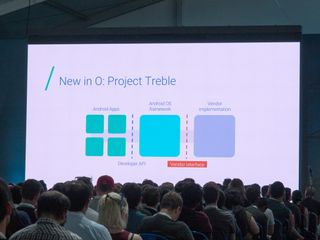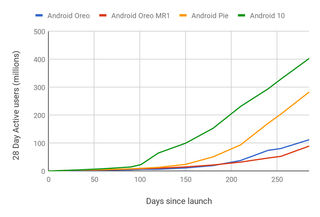Android updates are coming faster than ever, but still too slowly to catch Apple

Thanks to Project Treble, Android phones are getting updated faster than ever before. Android has its fair share of issues, but for most people, the biggest is how long it takes to see a software update after Google announces one.
We've all been there; you see this new software with a feature or two you really want to come to your phone, but it takes what seems like forever for it to arrive and you know Google is ready to announce another new update by the time you get it. It's a nasty circle that acts as the biggest black eye on Android as a whole.
There's good news, though: it's getting better. A lot better.
Android updates will never come as fast as iOS updates because everything is different.
Don't think this is any kind of Google flexing at Apple because there is still a huge disparity. Google tells us that Android 10 adoption was the fastest ever with 100 million phones running Android 10 just 150 days after it launched. That's great, but Apple's iOS 13 also launched in September 2019, and saw 600 million phones running it in just 30 days. Google will never have update numbers like Apple because Android and iOS are very different.
What's great about seeing 100 million users in five months is how it compares to prior versions of Android where Project Treble wasn't much of a factor. Just one generation earlier, it took roughly 210 days for Android 9 Pie to hit the 100 million user mark.

In simple terms, Project Treble was Google's way of trying to separate the Android software it creates from the other software that's required to have a working phone. Companies that build phones and companies that build the parts — like that fancy Snapdragon 865 — used inside a phone often need to have bits and pieces of software running and Google has no control over any of it. When that software needs to be bundled in it takes longer to build and send an update. If that software isn't bundled in and doesn't need to be updated, then Google's software can come to your phone faster. And now, it does.
Google gets credit for developing Project Treble, but phone makers are the companies that actually made it work.
Of course, the details are complicated, which is why phone manufacturers were given time to build compatible products. Phones that shipped with Android 8 from the factory needed to be compliant and ready for Project Treble. And companies building phones needed time to adjust — the teams that take the Android source code and turn it into something that makes a Galaxy S10 actually work can't change direction overnight. So we didn't see the immediate effects of Project Treble all at once on Android 9.
Be an expert in 5 minutes
Get the latest news from Android Central, your trusted companion in the world of Android
By now all Android phones ship ready for Project Treble and companies building them have had a year or so to adapt. That gives us what we see today: 150 days to reach 100 million phones running Android 10, compared to the 210 or so days it took to see 100 million phones running Android 9. Such a big jump is a clear indicator that both Google and its hardware partners are doing a lot to get updates to you faster.
Updates aren't everything, and because of the way Android is distributed they will never come instantly. This is why Google has also worked out other ways to get new features and better security to phones itself like Project Mainline and Play Services. But seeing such a huge uptick over just a year proves that whatever is happening is working.

Jerry is an amateur woodworker and struggling shade tree mechanic. There's nothing he can't take apart, but many things he can't reassemble. You'll find him writing and speaking his loud opinion on Android Central and occasionally on Twitter.
